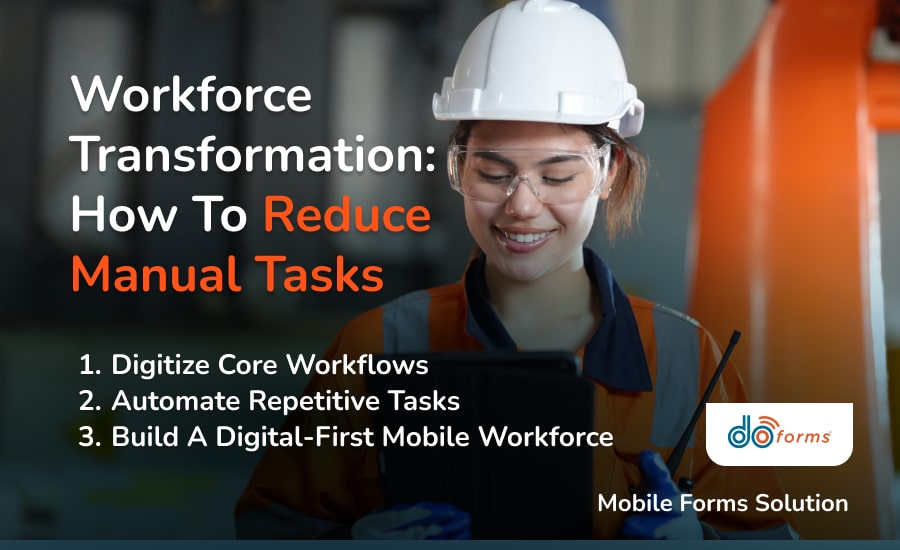
Up to 80% of businesses are moving towards flexible work schedules and remote work. Do you have a workforce management system in place? And if so, is it ready to keep up?
Workforce management can help you maintain both internal and external communication, assign tasks, keep up with scheduling, review performance metrics and more.
This, in turn, allows you to stay on top of your day-to-day operations, whether your team is in-house full-time, working from home, working in the field or on the go.
But what is workforce management exactly? And what does it entail?
In this article, we’ll define workforce management, explain its benefits and share how our doForms expert tool can help you improve your business processes.
Digitalize your checklists with doForms.
Try doForms for free!
Table of Contents
What Is Workforce Management?
Workforce management (WFM) is a set of processes and activities used within a company to optimize the productivity, efficiency and performance of its workforce.
For example, if you are managing a construction company, workforce management will allow you to plan the workload and create employee schedules to ensure there are enough workers and resources at the site so that there are no work delays.
Or, if you are working in retail, you may schedule your employees’ working hours to align with peak shopping times to ensure excellent customer service.
Workforce management includes:
- Workforce planning to align current and future demands
- Employee scheduling to prevent overstaffing or understaffing
- Employee training to enhance employee skills
- Transparent communication to ensure that employees are well-informed about expectations and changes
- Performance reviews to identify strengths and areas of improvement
- Utilizing technology and automation tools to streamline routine tasks and provide employees with time for more strategic activities
Key Elements Of Workforce Management
The elements of workforce management encompass various aspects of planning, organizing and optimizing an organization’s workforce.
Here are the four main elements:
1. Labor Force Forecasting
Forecasting of the labor force involves predicting future staffing needs based on historical data, current trends and anticipated changes in business demand.
It’s a critical aspect of workforce planning that helps you ensure you have the right number of employees with the appropriate skills to meet your business’ operational requirements.
For example, if you are managing a retail company, you can use labor force forecasting to predict an increase in your customer demand during the holiday season and plan to hire additional temporary staff to meet the surge in workload.
2. Scheduling
Scheduling focuses on creating employee schedules that align with the needs of your business, ensuring that there is adequate coverage during peak times while minimizing overstaffing during slower periods.
Scheduling employees for their optimal time slot makes for more engaged and productive workers, which helps ensure quality work and enhances customer satisfaction.
For example, if you are managing a manufacturing plant, scheduling can help you assign specific shifts to production line workers to ensure that daily production targets are met.
3. Time and Attendance Management
Time and attendance management includes managing employee work hours, break times and attendance.
This allows you to comply with labor laws, track productivity and calculate payroll correctly.
For example, if you are managing a construction team, you can implement a mobile app that allows your workers to log their work hours, breaks and project activities, providing real-time visibility and ensuring accurate payroll processing.
4. Performance Management
Task & performance management includes assigning tasks, setting performance goals and tracking employee performance.
The aim is to ensure that all your employees are working efficiently and meeting their targets.
For example, if you are managing a real estate company, you can assign your agents to achieve a certain number of property sales per quarter.
Benefits Of Effective Workforce Management
From improved productivity and cost reduction to enhanced employee satisfaction, effective workforce management provides multiple benefits for your business.
- Improved productivity: Optimizing schedules and task assignments ensures that your employees are engaged in productive activities, which reduces downtime.
- Cost reduction: Minimizing overstaffing allows you to control labor costs, overtime and other expenses.
- Enhanced employee satisfaction: Well-balanced working schedules and opportunities for skill development increase employee satisfaction and retention.
- Better customer service: Planning and scheduling resources leads to increased customer satisfaction, loyalty and repeat business.
- Competitive advantage: A well-managed team allows your business to deliver products and services more efficiently than your competitors.
- Increased profitability: The optimization of resources and processes helps you reduce costs and increase revenue opportunities.
How To Implement Effective Workforce Management In Your Company
To implement effective workforce management within your company:
1. Assess Your Current Workforce
Evaluate your current workforce, including skills, strengths, weaknesses and staffing levels.
- Identify specific skills and competencies present in your workforce which are relevant to your industry
- Understand how your workforce contributes to the company and define areas where you can make improvements
- Examine the current staffing levels per department and assess whether there are gaps or redundancies
2. Set Clear Objectives
Define specific and measurable objectives to be achieved by your workforce management strategy.
Your SMART objectives need to include specific, measurable, achievable, relevant and time-bound goals.
Examples of objectives include:
- Decreasing overtime expenses by 15% within the next fiscal year
- Increasing overall employee productivity by 10% over the next quarter
- Reduce employee turnover rate by 5% in the next year
Identify key performance indicators (KPIs) to measure the success of your workforce management strategy.
Examples of KPIs can include:
- Change in employee turnover rate
- Change in productivity levels
- Change in cost savings
3. Develop A Workforce Plan
Create a strategic workforce plan outlining your organization’s future staffing needs, skill requirements and strategies for optimizing workforce efficiency.
- Forecast future staffing requirements based on current capacity, business projections and plans for growth
- Define the skills and competencies that will be crucial for the future success of your company
- Set plans for recruitment, training and talent development
4. Train Your Employees
Invest in training programs to enhance employee skills and ensure each of them is equipped with the necessary knowledge and skills to perform their role.
While there is an initial investment in training, it results in long-term cost savings. Trained employees are typically more productive and make less errors, hence reduce operational costs and the need for corrective measures.
- Identify skill gaps and areas of improvement
- Develop training programs tailored to address these gaps — these can include external courses, in-house training sessions or e-learning modules
- Foster a culture of continuous learning
5. Organize Employee Engagement Initiatives
Develop programs to boost employee morale, job satisfaction and engagement.
Engaged employees tend to be more motivated and committed to their work, which leads to higher levels of productivity and efficiency. In addition, engaged employees are more likely to stay with your company, which reduces turnover costs and retains knowledge within the organization.
- Implement programs that recognize and reward employees
- Set channels for employee feedback and communication — these can include one-on-one meetings, employee surveys or suggestion boxes
6. Invest In Workforce Management Software
Choose and implement workforce management software and tools that align with your company’s needs.
Look for a tool that:
- Offers various features, such as employee scheduling, time and attendance tracking, and analytics
- Can be integrated with other systems used in your company
- Is easy to use by both employees and managers

To implement workforce management in your company, assess your current workforce, set clear objectives and develop a workforce plan.
What Is Workforce Management Software?
Workforce management software (WFM software) is a specialized suite of applications designed to streamline and optimize various workforce aspects within your organization.
WMS software typically includes modules for employee scheduling, time and attendance tracking, performance management and other workforce planning and optimization functionalities.
Using workforce management software allows you to:
- Streamline your processes: The use of automation and digital workforce management tools reduces manual paperwork and improves operational efficiency.
- Make strategic decisions: Workforce data and analytics provides insights which allow you to adapt to the changing market conditions and optimize your operation for future growth.

Workforce management software allows you to streamline your operation and make strategic decisions about your workforce.
Optimize Workforce Management With doForms
doForms is a leading mobile forms solution used by various businesses across industries.
It enables you to capture and send information to and from the field via smartphones and other mobile devices — and seamlessly integrate this data into your existing systems such as Salesforce.com, SAP, Oracle, QuickBooks, Microsoft, Google Suite and more.
doForms saves your company time and money by streamlining processes and cutting down on paper. It can be used to build, edit and send out forms to clients and even track how often each form is used.
doForms ensures that all your forms are up-to-date, from employee records and company policies to client agreements, invoice templates and more.
With doForms you can:
- Sync automatically timesheets and payroll processes
- Keep track of your business cashflows
- Keep track of your employee performance through forms like self-scoring surveys
- Provide instant feedback on holiday requests and view remaining allowances
Using doForms saves time and effort for you and your employees as well as reduces paperwork and employee errors.
Digitalize your checklists with doForms.
Try doForms for free!
FAQs About Workforce Management
To explore further how workforce management can profit your business, check out our FAQs section.
1. What is the difference between workforce management and human resource management (HRM)?
While workforce management focuses on optimizing workforce performance and productivity, HRM includes a broader range of functions, such as recruitment, onboarding and employee relations.
2. How does technology help workforce management?
Technology plays an important role in automating workforce management processes. Its use helps improve data accuracy and provides real-time insights into workforce performance, assisting you in taking informed decisions.
3. How does workforce management benefit your employees?
Workforce management can benefit your employees by ensuring balanced work schedules, opportunities for skill development and a positive work environment.
4. What is the role of analytics in workforce management?
Workforce analytics uses data and metrics, offering insights into workforce performance, trends, and cost-effectiveness. Based on these insights, you can take decisions and improve the work of your company.




